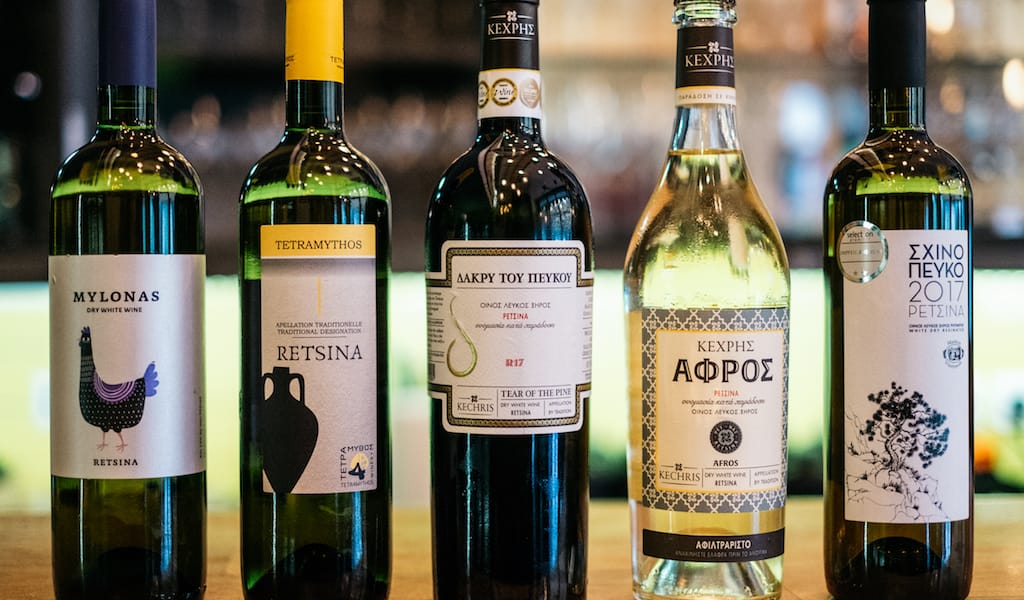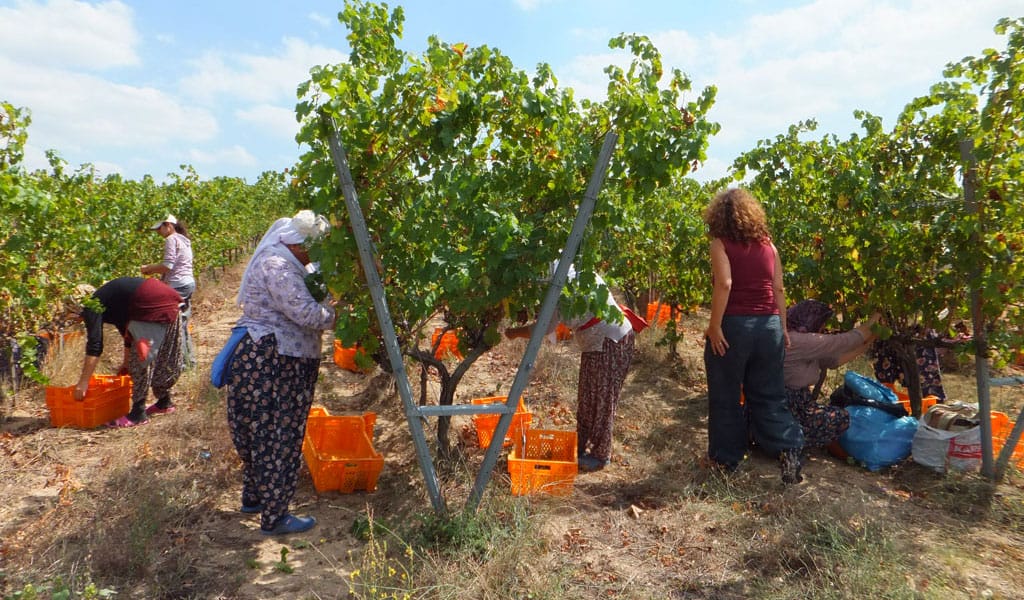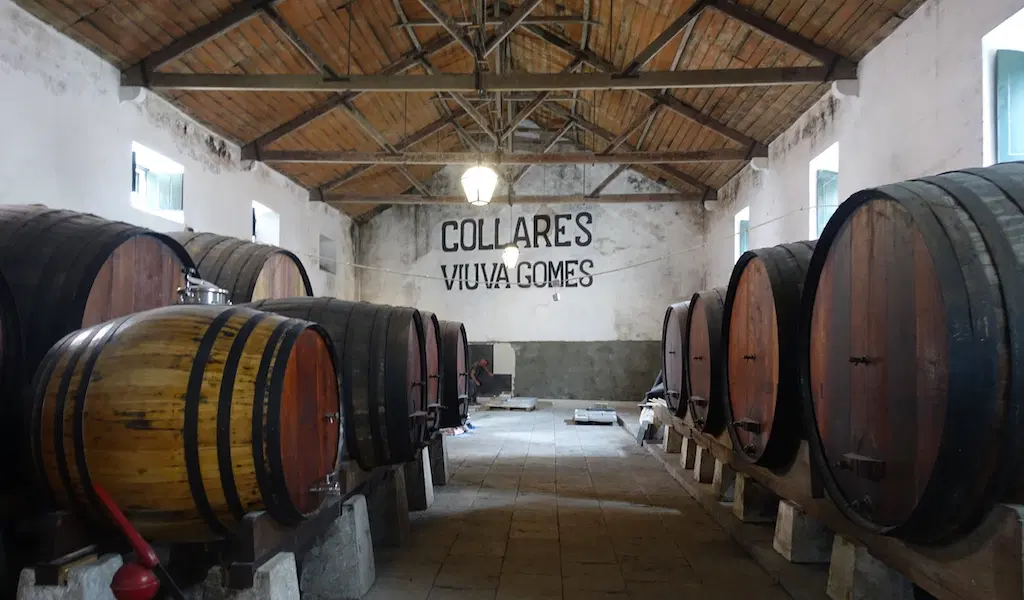Retsina has a bad rap. Many locals and foreigners associate this Greek classic with cheap “house wine” served at tavernas – you know, the stuff that is bright yellow in color, has an intensely resinous flavor and practically guarantees a headache the next morning.
But we think retsina is just misunderstood. Increased demand in the 1960s for this resin-infused wine led to a plunge in quality, sullying its good name. Yet a new generation of Greek winemakers and sommeliers has worked tirelessly over the last decade and a half to restore retsina’s standing in the international world of wine, experimenting with different grape varietals and methods of fermentation in the process.
The story of retsina goes back a few thousand years at least – in fact, most historians believe it was first made around 4,000 years ago, when ancient Greeks used to seal wine in ceramic vessels, mainly terracotta amphorae. To prevent oxidation caused by the porous clay, they started coating the inside of these vessels with resin – a sticky organic substance procured from pine trees – making them air- and water-resistant. The tops of these vessels were also sealed with resin to keep oxygen out. Some of the oldest discoveries demonstrating this winemaking process were unearthed on the island of Crete, dating back to 2,700-2,200 BC.
Apart from keeping wine in good shape for longer, this process also infused it with the natural piney aromas of the resin. Its unique flavor soon became popular, leading to the birth of the category of wines known as “resinous wines,” which during antiquity were regarded highly and fetched a greater price, especially since regular wines often had faults – usually from oxidation – back then. There are even records of resinous winemaking in other parts of the Mediterranean region during antiquity, such as in the Po Valley in northern Italy and on the southern coast of France.

Resin extracted from the Aleppo pine (Pinus halepensis), which thrives in the Attica region and on the island of Euboea (Evia), was, and continues to be, prized for this type of winemaking. According to Aris Sklavenitis, who has been named Best Greek Sommelier two years in a row by the Panhellenic Association of Sommeliers and is the co-owner of Oinoscent, a wine bar in downtown Athens, the timing of the resin harvest is critical in the process of making high-quality retsina. It should ideally take place about a month after the grape harvest, when the resin is at its freshest. (These days retsina is made by adding pine resin to the grape must during the fermentation process and then removing it once fermentation is complete.)
Yet as winemaking became more nuanced and the process was modernized over the centuries, it became more common for the pine resin to be used in order to mask poor quality grapes. This was particularly the case in the 1960s, when demand for retsina peaked: large quantities of resin were added to deeply flawed wines, damaging retsina’s reputation and the general perception of Greek wines abroad.
As retsina became synonymous with cheap, headache-inducing wine, it decreased in popularity. While over the course of the 19th century most tavernas around Attica produced their own retsina, usually from grapes growing around Mesogea, the eastern region of Attica close to the Athens airport, this practice petered out; starting in the 1970s, retsina became more widespread in northern Greece.
Recently winemakers have been experimenting with other varietals, to excellent results.
In recent years, however, retsina has experienced a remarkable change in fortune. Since 2005, so-called “new age” retsinas have become much more refined and competitive with non-resinous wines. “It all began with Kechris, a winemaker in northern Greece, who envisioned this upgrade and started producing this new generation of retsina,” says Sklavenitis. Their highly regarded Tear of the Pine label, which was introduced in 2006, was made from Assyrtiko grapes, a Greek white wine varietal native to Santorini that is not traditionally used for retsina. It was a move that inspired other winemakers and surprised consumers, paving the way for other important wineries to enter the retsina market, such as Gaia Estate and Tetramythos, whose retsina is made from Roditis grapes grown at an altitude of 800 meters and fermented in amphorae, like in ancient times.
Although produced all across Greece nowadays, retsina is most closely associated with Attica and the areas around it. The main production centers are Attica, the neighboring region of Boeotia and the island of Euboea; in fact, the European Union has awarded retsina a Protected Designation of Origin (PDO) with 15 geographical indications, all of which are in Attica, Boeotia and Euboea. “According to the existing law, this traditional appellation does not allow the winemakers to add a date on the label,” Sklavenitis points out.
Whether white or rosé, retsina is most often made with Savatiano and Roditis grapes (varietals mainly found in Attica). But recently winemakers have been experimenting with other varietals, to excellent results.
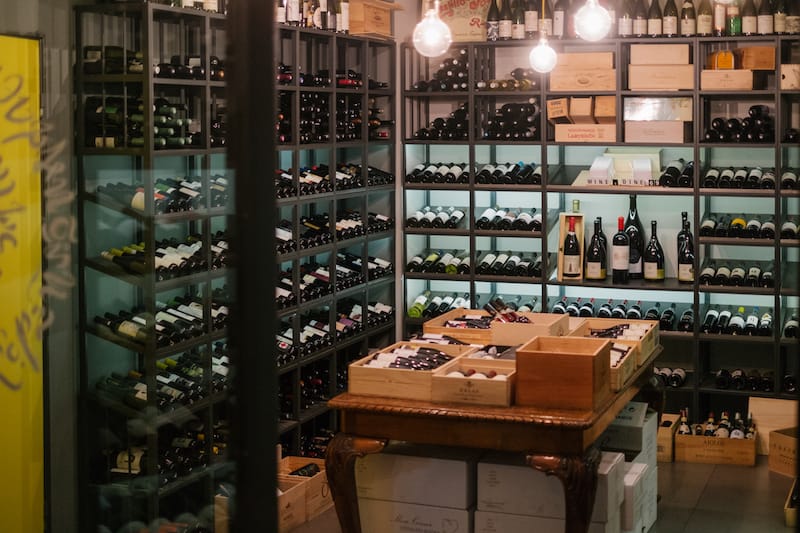
Taste-wise, high-quality retsina is crisp, refreshing and full of character – a light-bodied wine with a medium acidity level and slightly bitter flavor. Its aromas are fine and often include notes of – not surprisingly – pine trees and resin as well as herbs and citrus fruits like lemon and grapefruit. Unlike the amphorae of yore, the traditional fermentation process occurs in wooden barrels (preferably oak or pine). Nowadays, though, many wineries use large stainless steel tanks.
We enjoy retsina as an aperitif or paired with classic Greek mezes and seafood dishes, particularly fried seafood. It is also the perfect accompaniment to most “wine killers,” those foods that are difficult to pair with wines such as garlic, artichokes, eggs, asparagus, ginger, and smoked and cured foods.
Many wine bars and restaurants around the country now stock these modern retsinas; in Athens, Oinoscent is hands-down our favorite spot for resinous wine. Most recently, we have been enjoying the sparkling retsinas produced by Kechris, the original game-changer, and Nikolou; both are remarkably innovative wines, each (Afros from Kechris and Botanic from Nikolou) with its own unique character. There are a few other wineries whose retsinas we never hesitate to order if we see them on the menu: Papagiannakos, Georgas Family (both their regular retsina and the organic version), Gikas (the producers of Pine Forest), Domaine Vassiliou, Mylonas, and Markou Vineyards.
Although we tend to avoid house retsinas, there are a few exceptions that provide a more traditional experience and are worth mentioning. To Eidikon is an old-school grocery store and eatery in Pireaus where you can enjoy a jug of homemade retsina along with a few meze dishes, while at Diporto, a taverna right by the central food market in downtown Athens, the owner and cook, Mr. Dimitris, serves up his own retsina, straight from the wooden barrels to your table.
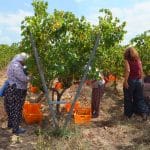 October 5, 2019 Wine Harvest Week
October 5, 2019 Wine Harvest Week
Zeynep Arca Şallıel had a successful career in advertising in Istanbul, but in 1995 she […] Posted in Istanbul November 16, 2018 Grape Expectations
November 16, 2018 Grape Expectations
Turkish wine is something of a paradox. Despite being one of the oldest winemaking […] Posted in Istanbul September 14, 2018 CB on the Road
September 14, 2018 CB on the Road
They withstood the phylloxera and the strong Atlantic winds, and are slowly fighting […] Posted in Lisbon
Published on April 17, 2019
Related stories
October 5, 2019
IstanbulZeynep Arca Şallıel had a successful career in advertising in Istanbul, but in 1995 she decided to take on a daunting new challenge: taking part in the revival of small-scale viniculture in the ancient winemaking region of Thrace.“I wanted to do something with soil, something that mattered a little bit more,” she says. Her father…
November 16, 2018
Istanbul | By Andrea Lemieux
IstanbulTurkish wine is something of a paradox. Despite being one of the oldest winemaking countries on earth, Turkey is by no means a big wine-drinking country. Go to any bar or meyhane in Istanbul and you’re more likely to see people guzzling large pints of frothy beer or swirling delicate glasses containing cloudy rakı. Yet…
September 14, 2018
LisbonThey withstood the phylloxera and the strong Atlantic winds, and are slowly fighting back against urban expansion, so it’s no surprise that a glass of wine made from grapes grown in Colares tastes like no other. The smallest wine region in Portugal, Colares is also probably one of its most distinct. Located on the coastline…







































